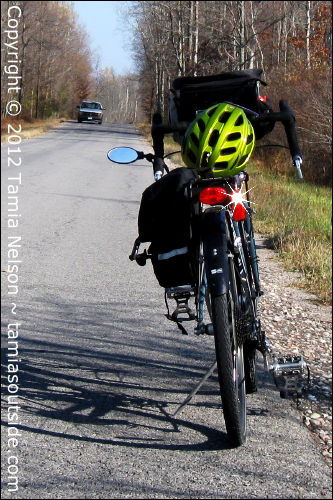Do you think bicycle headlights and taillights are just for night rides? Think again.
______________________________
by Tamia Nelson | March 22, 2018
Originally published in different form on January 28, 2014
![]()
The months between the autumnal and vernal equinoxes are a time of short days and long shadows. This has important consequences for cyclists who venture onto public highways. The low winter sun poses the greatest danger. Late in a March day, an impatient motorist driving toward the fiery orb hanging just above the western horizon is sure to be all but blinded by the dazzling light. There’s almost no chance she’ll spot a cyclist in the road ahead of her in time to swerve or brake.
Are you feeling lucky today? It’s a question I often ask myself before pedaling away.
Of course, we cyclists are forced to rely on the kindness of strangers for our very survival all year round. Motorists who are alert, competent, and well-disposed pose few problems. But not every motorist embodies these happy qualities.
OK. What can cyclists do to improve their odds? Very little, as it happens. Existing licensing standards don’t do much to ensure that non-commercial drivers possess even minimal competence. They don’t even guarantee that license-holders have the physical ability to steer a car between the white lines. My own state floated the idea of allowing drivers to “self-certify” that they could see the road when they renewed their licenses. This suggestion was torpedoed at the last minute, but I’m confident it will soon resurface.
As for motorists being well-disposed, well, consider this: Some “experts” estimate that at least one driver in 100 is a psychopath. You can’t expect a psychopath to care whether or not he maims or kills you with his car — providing it doesn’t inconvenience him, that is. And given the lenient treatment meted out by American courts to motorists who kill cyclists and then flee the scene, the psychopaths in our midst have nothing to fear from the short arm of the law.
That leaves cyclists with just one hope. While we can’t do much to get the attention of a driver who’s texting or watching a movie while he drives, we can do a few things to warn responsible drivers of our presence.
Hi-viz and reflective clothing helps, but it’s not enough in itself. A more active defense is necessary. I favor strobes. A brilliant red strobe behind. A bright white strobe ahead. And this is no place for half-measures. “Brilliant” and “bright” mean what they say.
I’ve put this theory to the test. I cycled an eight-mile loop on a mix of rural and state highways. On the first lap, I rode without my usual complement of strobes. (What lights? A RADBOT 1000 taillight and a Planet Bike Blazer 2W headlight, if you’re interested). For my second loop, I switched the lights on and repeated the same circuit, when the sun was lowest and the glare most intense. The upshot? There was little doubt that the strobes had an effect. When my lights were flashing fore and aft, drivers saw me sooner (I could see overtaking motorists in my rearview mirror) and they ceded me a greater share of the road when they did.
Was this a rigorous, scientific trial? No. That said, the evidence was certainly suggestive. And I’ve often been told by drivers who have seen me on the road that the flashing lights drew their eye far more effectively than a steady light. One of these drivers, a pro who drives hundreds of miles every day, provided detailed analysis of why she believed bike strobes fore and aft are the way to go, giving drivers plenty of time to gracefully allow plenty of passing room.
The Bottom Line?
No strobe, however bright, can get the attention of a motorist who’s dozing off, or reading, or kissing his girl. Nor will a flashing light elicit empathy from a psychopath. Still, we cyclists have to take what we can get. We can’t compel cops and courts to enforce the laws, even when that failure endangers the lives of cyclists and pedestrians. Nor can we awaken a feeling of compassion in a man or woman to whom such emotion is entirely foreign. But how and when we light up is our decision. It’s one thing we can do to improve the likelihood that every trip will have a happy ending. And that’s good enough for me.
One last point. Glare affects cyclists, too. So if you’re riding into the sun, slow down and look sharp. There’s probably a crack in the pavement ahead with your name on it.
News flash! It seems I’m not alone in my belief that flashing makes good sense for cyclists. Check out this article from the LondonCyclist website.

